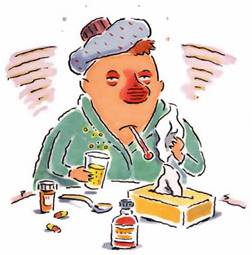Friday Author: Seth Kaplan
 Oy! When you’ve got a cold, you hurt all over, especially your chest. Coughing, post-nasal drip and / or a runny nose, achy ears, scratchy throat, sneezing, even headache accompany the pain. (Not fever, though. If you have a fever, you may have the flu.)
Oy! When you’ve got a cold, you hurt all over, especially your chest. Coughing, post-nasal drip and / or a runny nose, achy ears, scratchy throat, sneezing, even headache accompany the pain. (Not fever, though. If you have a fever, you may have the flu.)
You feel sick and, yet, for all the misery colds cause, people—like your boss for example—consider them minor ailments. That’s probably because everyone gets colds and assumes you will work through them.
Most people will try different approaches to managing their colds so they can continue to function at school, work, and home. It is interesting that many Americans push themselves to perform when ill. Workers in other countries do not do this, as they receive paid sick leave from work when they are ill.
 Here is a short list of the preparations that folks use:
Here is a short list of the preparations that folks use:
- Over the counter cough medicines and anti histamines
- Multi-vitamins
- Chicken soup
- Apple cider vinegar
- Grandma’s cod liver oil
- Plants and herbs that support the immune system; e.g., mushroom, oregano, olive leaf
- Last but not least, large doses of Vitamin C
How Vitamin C Helps Manage Colds
Because our bodies do not manufacture Vitamin C (or ascorbic acid), we have to ingest either foods containing Vitamin C (fruits, green leafy vegetables, many herbs like rose hips, paprika, fennel, kelp and hops) or supplemental Vitamin C pills. BTW: No, you can’t get Vitamin C from the hops in beer. Sorry.
 As with beer, though, the body excretes Vitamin C quickly. The recommended daily amount for Vitamin C is 90 Mg. The most one can absorb at any one time is 200 Mg, although researchers now question these long-held assumptions. A doctor told me, however, that he takes 3 grams, or 3,000 Mg, every day, probably in divided doses. Now that I am sick, I am taking 4 grams, or 4,000 Mg, in two divided doses.
As with beer, though, the body excretes Vitamin C quickly. The recommended daily amount for Vitamin C is 90 Mg. The most one can absorb at any one time is 200 Mg, although researchers now question these long-held assumptions. A doctor told me, however, that he takes 3 grams, or 3,000 Mg, every day, probably in divided doses. Now that I am sick, I am taking 4 grams, or 4,000 Mg, in two divided doses.
Once we put Vitamin C in our bodies, here are eight of the more than 300 ways it helps us:
- Taking 1 gram (1,000 Mg) of Vitamin C will reduce the severity and duration of colds, but not how many colds one can get—unless one is an ultra-athlete. That, however, raises mortality issues due to stress, another topic.
- Protects against the effects of pollution
- Protects against infection
- Protects against immune-senescence, the age-related deterioration of the immune system
- Helps prevent cancer
- Helps produce anti-stress hormones and interferon
- Binds to harmful substances in, like lead, so the body can eliminate them. (Everybody in Flint, MI, and other locales where aging infrastructure poisons the populations should be mega-dosing on Vitamin C and going to saunas to sweat out the metal contaminants.)
- Prevents scurvy. Yes, scurvy. It, along with rickets and those other diseases you learned about in grade school, is still found in our fair land. In fact, 23% of Americans do not get enough Vitamin C, according to the November/December 2015 issue of Life Extension
What Kind of Vitamin C to Take
 What kind? Isn’t Vitamin C just Vitamin C? Yes and no. Feeling disingenuous yesterday, I asked my pharmacist whether the store carried ascorbate, as distinct from ascorbic acid. He assured me that they were identical substances.
What kind? Isn’t Vitamin C just Vitamin C? Yes and no. Feeling disingenuous yesterday, I asked my pharmacist whether the store carried ascorbate, as distinct from ascorbic acid. He assured me that they were identical substances.
What it is not back to the target range for him, there is a difference between the two. You can buy Vitamin C as ascorbic acid or Vitamin C as ascorbate. As Phyllis Balch, author of “Prescription for Nutritional Healing,” writes:
“Esterified Vitamin C, or Ester-C, is created when Vitamin C reacts with a mineral, like calcium, magnesium, potassium, sodium, or zinc. Ester-C is non-acidic and contains Vitamin C metabolites identical to those produced by the body. Ester-C enters the bloodstream and tissues four times faster than ascorbic acid because it is more bio-available and better absorbed. For older people, this means their white blood cells will hold four times more ascorbate than ascorbic acid, which means their immune systems will work better. Because ascorbate is better absorbed, less is excreted through urine.”
Don’t Take Vitamin C Indiscriminately
Older people do not usually need as much iron as do younger folks. To avoid having your Vitamin C bind to the iron in food, take it thirty minutes before, or two hours after, a meal. Conversely, if you want the iron, take Vitamin C with a meal.
If you take aspirin daily and have stomach acid issues, take the esterified form of Vitamin C and take it separately from the aspirin.
Should you become injured, know that internal injuries can produce iron. Cut back on or eliminate Vitamin C until you are healed.

Seth, I love your posts. I learn something every Friday!!